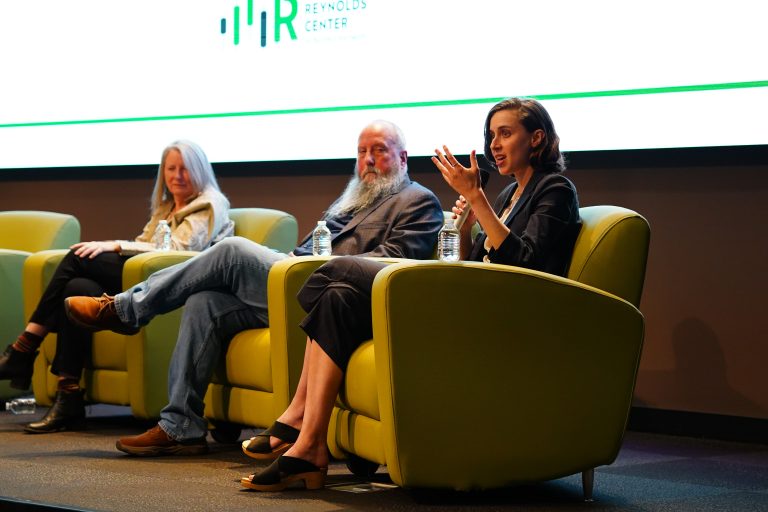Investigative reporters who emerged winners of the 17th annual Barlett and Steele Awards were recognized for their excellence in business journalism at an awards ceremony on Nov. 1, hosted by the Reynolds Center for Business Journalism at Arizona State University’s Walter Cronkite School of Journalism and Mass Communication.
Speaking during the ceremony, Reynolds Center Director Dr. Jeffrey Timmermans emphasized the importance of business journalism, especially its efforts to promote accountability and social justice.
After the presentation of the awards, James B. Steele – of the investigative journalism duo for whom the awards are named – sat down with representatives of this year’s Gold Award winners: Paige St. John of the Los Angeles Times and Jim Morris of Public Health Watch, and this year’s Outstanding Young Journalist Award recipient, Ava Kofman of ProPublica.
Steele began the conversation by congratulating the winning journalists for their resilience in exposing corruption and illegalities in various business sectors while urging students and other journalists in the audience to emulate the work the journalists have done.
“One of the most important tools you can do is read other journalists. Read the good things. Read the bad things. We’re also in an age where it’s really easy to do that,” he said.
Where to look for investigation inspiration
One of the first questions posed by Steele to the winners was what sparked their initial interest in their investigations. For St. John, the investigation began as a dreaded task to look at what was happening five years after California legalized cannabis for recreational purposes. When the ballot initiative – Prop 64 – passed in 2016 a lot of promises were made, but as St. John and her colleagues soon discovered, many of those promises remain unmet. The investigation led to an unexpected finding of corruption and social injustice along with the mistreatment of workers who were mostly undocumented migrants.
“This was a delicate assignment,” she said. “It was very frustrating. We spent a tremendous amount of time doing the investigation. We brought satellite imagery and data analysis, but the reporting on the field was really the icebreaker. The rumor of people dying became my primary focus.”
Public Health Watch’s Morris got the idea for his story based on a tip from a friend who told him a doctor at the University of California was seeing young Latino workers dying of silicosis – a rare lung disease – caused by the production of artificial stone countertops.
“This was a disease I knew very well. I had worked on a big project in Houston thirty years earlier,” said Morris. “Turns out it’s the biggest cluster of this disease, as far as we know, in the country.”
As for Kofman’s story on the hospice industry, “It was an editor’s idea,” she said. “It kind of started out as a word, as a subject, not really as a story, but I was poking around a few different things and my editor said, what about hospice?” Kofman noted that many of the basic facts of hospice were well known, but there weren’t a lot of deep insights into the industry as a whole. The industry had started out predominantly run by charities and non-profits as a service, but as of the time Kofman began researching it that had changed, with about 70 percent of hospices being run for-profit.
“In recent years there have been some studies showing that private equity ownership of hospice had tripled, which when you hear the words ‘private-equity’ it can always be interesting or a lead for a story.” Once Kofman began speaking to the people whose job it was to sign people up for hospice she realized that the things she was hearing from them were stories she hadn’t read before and that was the story she needed to write.
Getting around obstacles
“One really big obstacle with hospice is that the people you are writing about, for the most part, are all going to be dead. And measuring whether a death went well or badly is a lot more challenging than a typical med[ical] mal[practice] case … Lawsuits against hospice companies by individual patients and families are incredibly rare because the patient is supposed to die, right? So saying their care wasn’t quite right is quite difficult to litigate,” said Kofman. Additionally, Kofman found that the hospice industry doesn’t have the same kind of advocacy groups or political constituents that other areas of health care have so there wasn’t a built-in network of sources to contact.
Morris said his silicosis investigation went more smoothly than most because the workers were eager to speak to him and he felt lucky that the doctor he worked with was able to go on the record and connect him with many of the workers he subsequently interviewed. “We did not have to really convince them to talk. For an investigation, it was straightforward and relatively simple,” he said. Morris noted that sometimes you just get lucky, but building strong connections throughout your career can really help you later on down the road with future investigations.
A long investigation takes patience
One of the questions posed by a student in the audience was how to have the patience to complete a long investigative piece with care such as the ones that were being awarded.
St. John joked that “it’s not patience it’s masochism” because her instincts from her early days of working on a wire service were to go fast.
“The piece we did took about four months, which is not that long for an investigative piece,” said Morris, noting that many investigations can take a lot longer, but it’s important to understand when you have what you need for the story and not agonize over the story for extra time. “I try to tell younger journalists just don’t overthink it. It’s very easy to overthink it, oh I need 10 more interviews, I need ten more characters just like the three I’ve already got. No, you don’t, just write the story.”
“For me, my curiosity is what keeps me going,” said Kofman. “Just having so many more questions I want answered.”
Steele emphasized that he learned early on the importance of writing as you go along. Everything will need to be edited anyway and there was much to learn from just getting it out on the paper. “This doesn’t mean you’ve got the finished product, but you got something out and you’ve seen what’s there … Sometimes I thought I had a hole in the story and I would write it and I would find out I don’t. Inversely I would think something was done and there’s a huge hole in it,” he said.
Having patience for working on investigations is not only about the reporting and writing process, it can also be about what happens after the piece is published. Often reporters are expecting immediate impact, but that is often not the case.
“Sometimes [with] the most complex issues there is no immediate reaction… Part of your job is just to raise awareness of that issue and that seeps into the body politic over time. It’s not something that happens right away,” said Steele. “Reaction and change in America is sometimes very slow. But we in the press are at the very heart of that cause we can shine a light in areas that the public doesn’t know about and I think that’s our principal obligation and responsibility and duty.”
To learn more about all of the winners of the 2023 Barlett and Steele Awards and to read interviews with individual winners on how they did their investigation visit businessjournalism.org/awards. Watch the full conversation here.
Julianne Culey contributed to this article.












